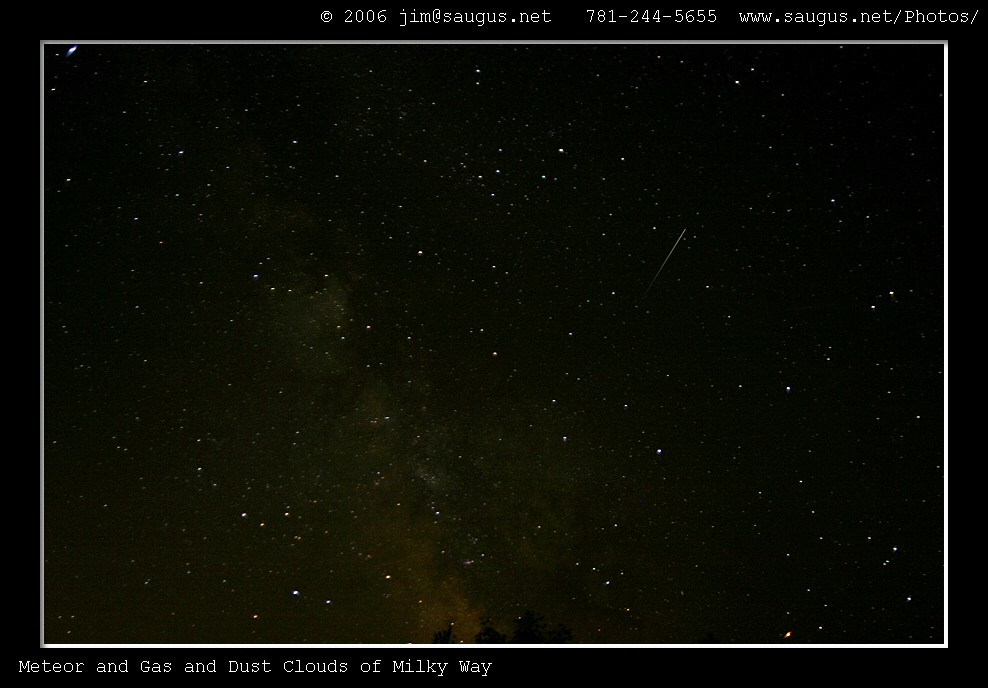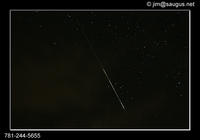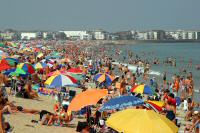Meteor Photography Tips
Astrophotography Tips
Scroll down for meteor photo tips.
This page created for Saugus Photos Online.
35MM Slides to Power Point
Meteor Photography Tips - AstrophotographyThis page is part of Saugus Photos Online and Copyright 2013 - Jim HarringtonThe meteor photograph above was made using a tripod, Canon 10D DSLR and a Sigma 20MM 1.8 lens. The exposure time was 30 seconds. ISO 200, F2.0. I made about a dozen 30 second exposures that night and was just lucky to have caught a meteor in one. The dark skies were provided at Glen Ellis Campground in Glen, New Hampshire. The image was enhanced in Adobe Photoshop by adjusting brightness and contrast . "Hot pixels" were cloned out. Along the bottom most portion of the image a silhouette of tree tops can be seen. The orange colored gas and dust clouds of the Milky Way Galaxy can be seen just above the trees, extending to about 1/2 way up the image. The meteor, is just above and to the right of center. If you don't see it, it's time for a visit to the optician. Meteor photography can be accomplished with most SLR cameras, including 35MM film and digital SLR cameras. I read somewhere that on an average night, at least 1 meteor per-hour can be seen when skies are dark enough. Meteor is the proper term for those objects causing streaks of light in the sky. A meteorite is the term for meteors which end up on planets or moons, after impact. Most meteors are small and burn up completely before ever reaching earth. Occasionally, hissing sounds accompany meteor occurrences. An extremely bright meteor is called a fireball. Be aware, I'm not a meteor photography expert. In fact, the meteor photo above is the only decent metor photo I've made. But, I have not spent much time trying, maybe 2 or 3 hours total. Four important meteor photography success factors1. Date of attempt: period of most meteors ( during known meteor showers ) 2. Location: Far away from city lights, light pollution ( a full moon is not good either! ) 3. Using the right photography or video equipment and settings 4. Right time of night , after midnight 5. Where camera is aimed ( shower radiant ) Capturing a meteor with a camera is not an easily accomplished task. The best meteor photos are made under the best conditions and with good equipment. Below are some meteor photography tips which might help you get meteor photos of your own.
If you enjoyed these meteor photo tips you'll surely enjoy my 35MM & Digital Photography Tips page. Make a permanant link to this page directly from your meteor or photography related page, and I'll retun the favor. Call me (Jim) at 4781-244-5655 or send e-mail to jim at saugus dot net. Put "meteor photography" in your subject line or your messeage might not be seen. Readers are welcome to submit photos, (any astrophotography) meteor photography tips or other content for publication here. For those of you who shoot 35MM slide film, I've created a page on the web for help with scanning 35MM slides to digital using the Nikon 5000 scanners. If you'd like to contribute please send e-mail to jim at saugus dot net (correct to normal e-mail conventions) Meteor Photography LinksRead Mr Leo Stachowicz response in this forum Meteor Photography Camera Clusters Meteor Photography by Jerry Lodriguss |
|
|
|
|
||


